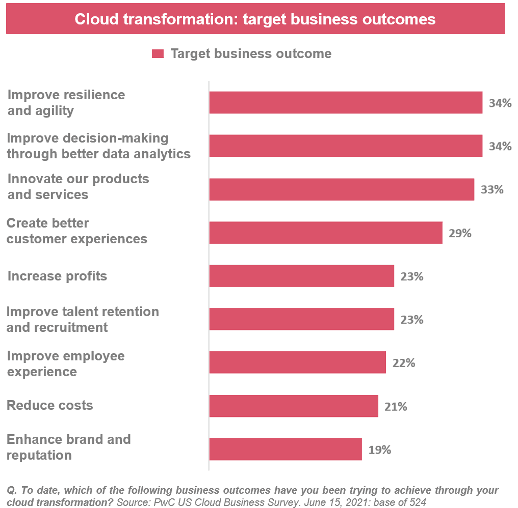Why are companies primarily going to the cloud?
According to, 56% of executives see cloud as a strategic platform for growth and innovation. Business leaders across the C-suite are now primarily going to the cloud to create new products and services, offer better customer experience and improve decision-making through enhanced data analytics. According to this study, such target business outcomes may even be of a higher priority than cost reduction.

Cloud transformation: target business outcomes PwC
Why do we need cloud to transform data into business value?
A recent study by IDC (International Data Corporation) estimates that the world will produce and consume 175 zeta bytes of data by 2025. This will keep increasing due to the rise of connected devices. To innovate and differentiate, companies should collect and make use of data originating from internal business activities, e.g., in relation to sales or customer support, as well as external data, such as information related to the competition, peers, or market trends. This will allow them to improve effectiveness, customer understanding, service quality and create a better customer experience. Cloud is the optimal choice for hosting such volumes of information and harnessing the value of data collected using emerging technologies such as AI.
A recent study by IDC (International Data Corporation) estimates that the world will produce and consume 175 zeta bytes of data by 2025.
Any company can integrate a prebuilt managed AI service offered by cloud providers, e.g., to process documents in bulk and extract relevant data. Additionally, we see more businesses turning to digital twin technologies, which are digital replicas of an asset, to improve their products or perform simulations under specific conditions. For instance, a healthcare company could test medical therapies on virtual patients and banks could better assess their risks when lending to their clients. Digital twins must leverage the infinitely scalable, high-performance computing power of the cloud to combine multiple sources of information, massive amounts of data and perform analysis on top of it.
Define a strategy to unlock business value in the cloud
First, organisations must adopt a good data integration practice when dealing with data coming from disparate sources (public and private clouds). According to Loic Dunand, Data Analytics leader at PwC Luxembourg, “A well-structured approach involves finding the right data based on a well-established strategy, using the right data model to store these data after integration, and managing their lifecycle applying DataOps principles. We are also seeing a growing trend of vertical SaaS business applications that are targeted at a particular industry. It will become increasingly difficult to enable consistent data exchange between a data platform and SaaS business applications, keeping in mind performance and cost constraints”.
Furthermore, it is of paramount importance to opt for cloud-native technologies. Data streams are generally highly variable and cloud-native services can support such fluctuations because they scale easily. Containers, service meshes and microservices offer significant scalability, deliver performance, resilience, and ease of management.
It is also valuable to consider open-source technologies. One reason is to allow the portability of data across different environments. It must be moved beyond silos and proprietary data formats. Another reason is to use state-of-the-art analytical services developed by the open-source developer community. Cloud providers usually offer open-source platforms as a managed service, such as Kubernetes (container orchestration) or Apache Kafka (distributed event streaming). When moving from one cloud provider to another, there could be some differences in their implementation, but the transition might not necessarily be an overwhelming challenge.
Robust cost management strategies must also be defined to ensure realisation of cost benefits of moving to the cloud. FinOps is a discipline that helps to promote a culture of cost accountability. Companies must provide cost visibility within their organisations, communicate around spend forecasts, and implement IT chargeback mechanisms.
Organisations are keen to collect more data and are even becoming increasingly skilled at monetising them.
Finally, data security and compliance with applicable regulations must be addressed during the early stages of the design of the cloud solution. Organisations are shifting to Zero Trust models to ensure that access is granted to only those authorised users that need it to company data seamlessly and safely from any device, anywhere across the globe. Data encryption or anonymisation techniques must be used to protect the privacy of personal data.
Organisations are keen to collect more data and are even becoming increasingly skilled at monetising them. The free flow of information has created a massive amount of business opportunities. Cloud is the key transformational technology that will reshape companies’ business models. Cloud is your engine while data is your fuel. Use them together and your business will reach new horizons.

